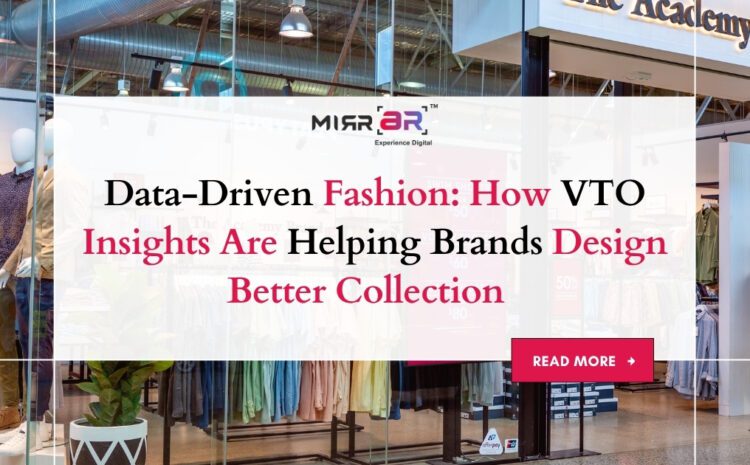In today’s digital-first fashion ecosystem, design decisions are no longer based solely on seasonal trends, intuition, or historical data. Instead, fashion brands are increasingly turning toward Virtual Try-On (VTO) technology to collect rich consumer behavior insights in real time. These insights, gathered at the very point of customer interaction, are revolutionizing how brands conceptualize, test, and design new collections. With VTO tools like MirrAR, fashion is now becoming as much about data science as it is about design.
The Evolution of Fashion Design in a Data-Rich Era
Traditionally, the fashion cycle involved trend forecasting, prototype development, runway showcases, and then production. While this method allowed creativity to flourish, it often led to overproduction, missed consumer preferences, and waste. VTO transforms this cycle by offering instantaneous consumer feedback before garments even go into mass production.
With thousands of try-ons happening virtually every day, platforms like MirrAR collect vital metrics such as:
- Time spent on each product
- Most tried-on SKUs
- Preferred colors, cuts, and styles
- Conversion rates post try-on
These actionable analytics enable brands to spot patterns, assess demand, and fine-tune their designs accordingly — all in real time.
Predicting Trends with Try-On Data
VTO technology acts as a live lab for consumer experimentation. When users try on items digitally, brands can observe:
- Which patterns gain the most attention?
- What fits are being virtually tried more frequently?
- What demographic is engaging with a specific design?
For example, if a certain silhouette is constantly tried but rarely purchased, it might indicate visual appeal but practical issues like comfort or sizing. Conversely, a simple cut with high post-try-on conversions might suggest potential for expansion into new SKUs or colors.
MirrAR’s AI-driven platform enables brands to predict future fashion trends by mapping such behaviors over time and across geographies, giving brands a competitive edge in product development.
Customizing Collections for Regional and Demographic Segments
In a globalized fashion market, a one-size-fits-all approach no longer works. VTO allows brands to analyze regional behavior and preferences, offering a route to hyper-localized collections.
For instance, MirrAR’s clients can see that customers in Mumbai might favor bright ethnic fusions, while shoppers in London prefer minimalist neutrals. These insights help design teams create geo-personalized lines without guesswork. Similarly, age and gender data help segment collections for different customer groups with increased precision.
By combining demographic data with try-on patterns, MirrAR ensures that brands don’t just design for the average consumer—they design for the right consumer.
Optimizing Inventory and Reducing Waste
One of fashion’s most persistent problems is overproduction and unsold inventory. Every missed guess in design or quantity becomes an environmental and financial burden. VTO data flips this risk equation.
By tracking early virtual engagement, MirrAR helps brands determine which pieces are likely to sell well, allowing them to:
- Produce bestsellers in higher volumes
- Limit production of underperforming designs
- Reduce markdowns, returns, and inventory costs
This creates a leaner, more sustainable supply chain—an essential step toward circular and ethical fashion.
Real-Time Feedback for Agile Design
Imagine launching a capsule collection and, within hours, knowing which designs users are gravitating toward. This isn’t a future fantasy—it’s the current reality with virtual try-on. MirrAR provides real-time dashboards and insights that design teams can access and act on swiftly.
This agility allows for rapid iterations, micro-collection drops, or collaborative designs based on customer inputs. The result? Fashion that is co-created with the consumer—responsive, relevant, and resonant.
Empowering Designers with Creative Confidence
For designers, data might sound limiting—but in practice, it’s empowering. Instead of flying blind, they gain validation for their ideas or feedback to improve.
MirrAR’s VTO platform integrates seamlessly into the creative process, helping designers:
- Test color palettes
- A/B test design variations
- Experiment with bold patterns or avant-garde cuts digitally before real-world investment
In many ways, VTO becomes a virtual sketchpad where ideas meet audience feedback instantly, enhancing creativity rather than stifling it.
The Path Forward: Intelligent Fashion Design
As AI and AR continue to evolve, the future of fashion design will increasingly be data-backed and digitally validated. VTO tools like MirrAR are not only transforming how consumers shop but also how fashion is conceived from the ground up.
In the coming years, expect more:
- AI-generated design suggestions based on VTO analytics
- Collaboration between design, data, and marketing teams
- Predictive algorithms determining next season’s top sellers
For brands that embrace this transformation, the benefits are manifold—higher conversion rates, stronger customer loyalty, reduced waste, and designs that truly resonate with their audience.
Conclusion
The integration of Virtual Try-On technology with data analytics marks a significant milestone in fashion’s digital transformation. MirrAR stands at the forefront of this movement, providing brands with deep, actionable insights that go far beyond appearance.
In this data-driven era, fashion is no longer just about dressing people—it’s about understanding them. With MirrAR’s Virtual Try-On insights, brands can finally design collections that are not only beautiful but also smart, sustainable, and customer-approved.
